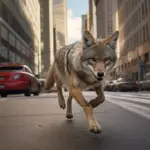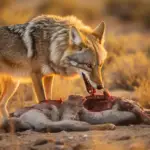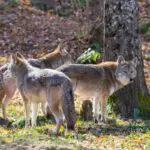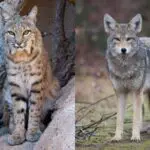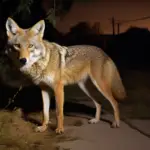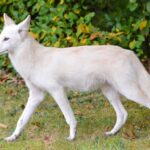Coyote dens, the secretive sanctuaries of one of North America’s most adaptable canines, are a fascinating study in survival and adaptability.
These hidden homes serve as a testament to the coyote’s resilience and resourcefulness, providing shelter, safety, and a place to raise their young in environments ranging from open prairies to bustling urban landscapes.
This article delves into the intriguing world of coyote dens, exploring what they look like, how to find them, and the vital role they play in the life of a coyote.
Coyotes, members of the Canidae family, are highly adaptable creatures known for their intelligence and survival skills.
One of the most intriguing aspects of coyote behavior is their denning habits. This article aims to provide a detailed understanding of coyote dens, how to find them, and what they look like.
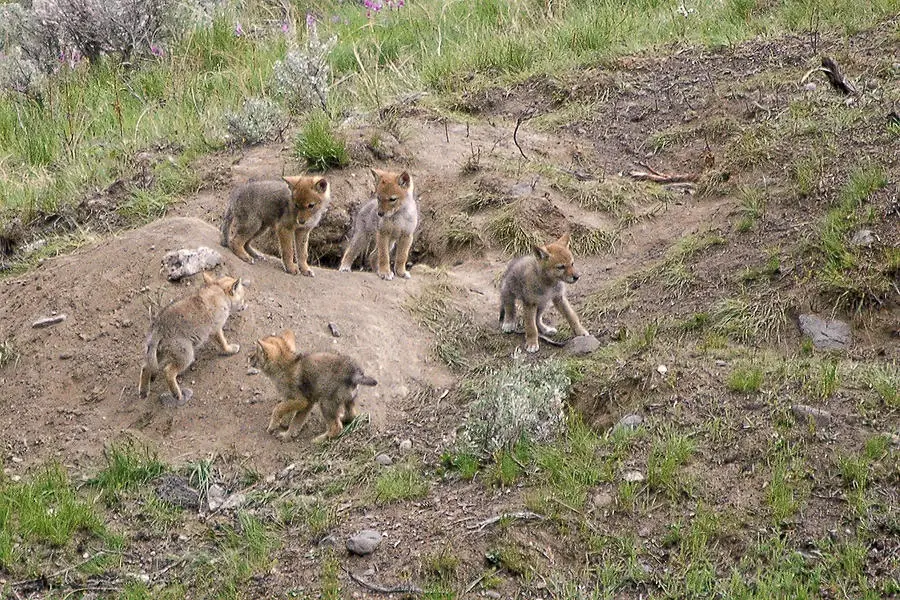
What is a Coyote Den?
A coyote den is a shelter used by these intelligent canines for birthing and rearing their young, and for sleep.
Coyotes do not hibernate, so their dens are not used for long-term retreats as seen in some other species. Instead, they serve as a safe haven for the vulnerable pups in the initial stages of their life.
What Does a Coyote Den Look Like?
Coyote dens can vary greatly in appearance. They are typically hidden from view and can be found in a variety of locations, such as:
- Under fallen trees
- Rocky ledges
- Abandoned burrows
- Hollow logs
- Under buildings
- In thickets
The den’s exterior is often marked by a fan-shaped mound of dirt, known as a “tumulus”, which the coyote digs out from the den. This mound, along with the presence of coyote tracks and scat, can be a clear indication of a coyote den.
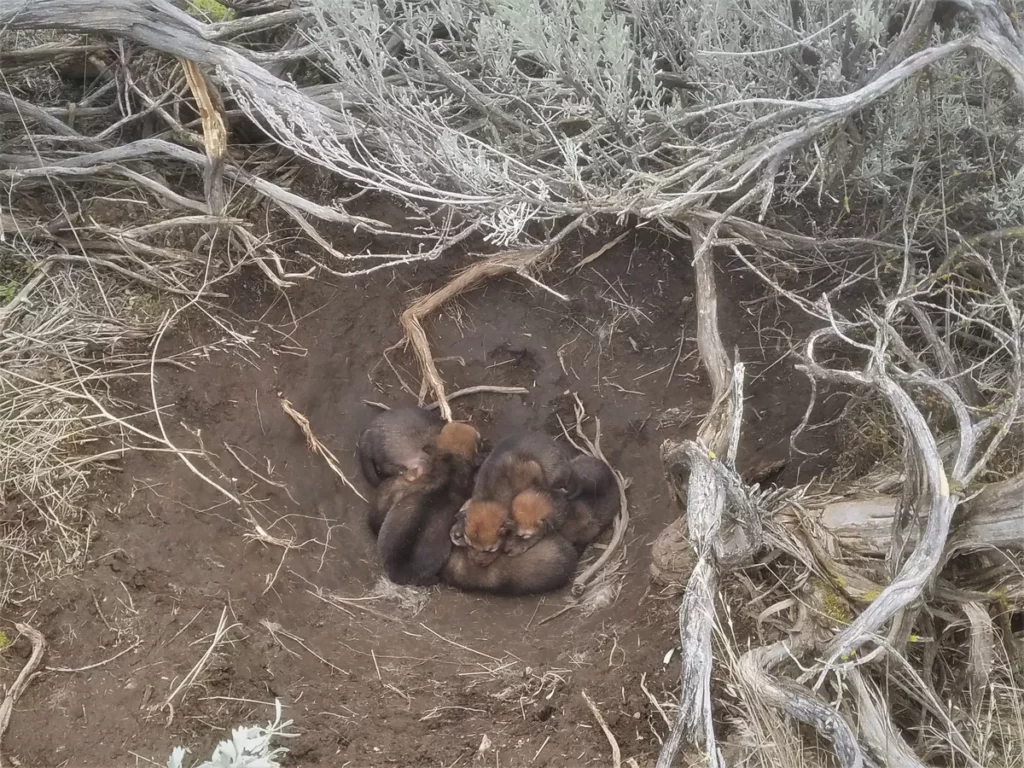
The entrance to the den is usually a narrow tunnel leading to a larger chamber. The den’s interior is often lined with grass, leaves, or other soft materials to provide comfort and warmth for the pups.
The size of the den can vary depending on the number of coyotes living in it. A den for a single coyote may be only a few feet in diameter, while a den for a family of coyotes may be several feet across.
Coyotes typically use their dens for sleeping, raising their young, and escaping from predators. They may also use their dens to store food or to hide from the weather.
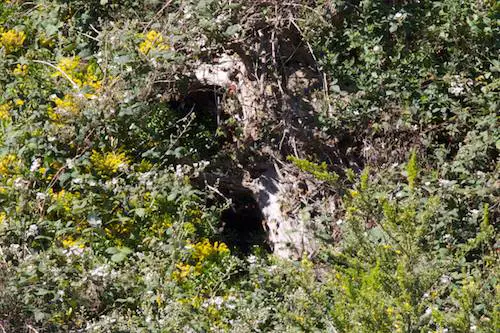
How To Find a Coyote Den
Finding a coyote den can be a challenging task due to their elusive nature and the often remote and hidden locations of their dens.
However, there are some signs that can help identify the presence of a coyote den. These include:
- Trails leading away from the den: Coyotes often create trails that lead away from their dens. These trails can be a good indicator of the den’s location. The trails will be worn down and may have scat or tracks along them.
- Scat and tracks: The presence of coyote scat and tracks around a certain area can indicate the presence of a den. Coyote scat is typically dark brown or black and is about the size of a golf ball. It may contain fur, bones, and other animal remains. Coyote tracks are similar to dog tracks, but they are slightly smaller and have longer claws.
- Vocalizations: Coyotes are known for their distinct vocalizations. If you hear a series of yips, howls, and barks, it could be a sign that a den is nearby. Coyotes are most active at dawn and dusk, so you are more likely to hear them during these times.
- Damage to property: Coyotes may den in abandoned buildings, under decks, or in other areas that provide shelter. If you see damage to property in your area, it could be a sign that a coyote is denning there.
- Coyote sightings: If you see a coyote in your area, it is a good idea to look for signs of a den nearby. Coyotes are typically shy and will avoid humans, but they may become more bold if they have young in the den.
If you find a coyote den, it is important to leave it alone. Coyotes are wild animals and can be dangerous if they feel threatened. If you have concerns about a coyote den, you can contact your local wildlife management agency.
Coyotes and Their Dens
Coyotes, like many other animals, are territorial by nature. They establish and maintain territories, which they defend from other coyotes and predators.
One of the ways they mark their territories is by using urine, a common behavior in many mammalian species. This scent marking serves as a signal to other coyotes that the area is already claimed.
In addition to scent marking, coyotes also use vocalizations, such as howls and barks, to communicate their presence and defend their territories.
When it comes to their dens, coyotes exhibit a heightened sense of protectiveness. This is especially true when they have pups. The den serves as a safe haven for the young, who are vulnerable to predators and environmental hazards.
If a coyote perceives a threat to its den or its pups, it may display aggressive behavior to ward off potential intruders. This could include growling, baring teeth, and even attacking if the threat persists.
Coyotes are also renowned for their adaptability, a trait that has allowed them to survive and thrive in a wide range of environments. This adaptability extends to their denning habits.
While coyotes are capable of digging their own dens, they can also modify and utilize existing structures to suit their needs. For instance, they might enlarge an old badger hole or adapt a natural hole in a rocky ledge to serve as a den.
This flexibility allows them to establish dens in a variety of locations, from open prairies and deserts to forests, mountains, and even urban areas.
Furthermore, their adaptability is not limited to their denning habits. Coyotes have a varied diet that includes small mammals, insects, fruits, and carrion.
This dietary flexibility, coupled with their ability to adjust their hunting strategies based on available prey, allows them to thrive in diverse environments.
Whether in the wild or in suburban areas, coyotes have proven to be resilient and resourceful, traits that are reflected in their denning habits and overall survival strategies.
Conclusion
Understanding the denning habits of coyotes can provide valuable insights into their behavior and survival strategies.
Whether you’re a wildlife enthusiast, a researcher, or a homeowner living in an area with a coyote population, this knowledge can help you coexist with these remarkable creatures.
- Sink Your Teeth Into This: Analyzing the Powerful Lion Bite Force - September 8, 2023
- Siberian Tigers: Everything You Need To Know - September 4, 2023
- Do Lions Eat Humans? Understanding Lion Aggression and Risks - September 4, 2023

